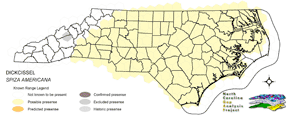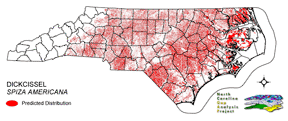
| Taxa: |
| Order: |
| Family: |
| Aves |
| Passeriformes |
| Cardinalidae |
| NatureServe Global Rank: |
| NatureServe State (NC) Rank: |
| G5 |
| SZB,SZN |
| Federal Status: |
| NC State Status: |
| --- |
| --- |


| Land Unit |
| US Fish & Wildlife Service |
| US Forest Service |
| US National Park Service |
| US Department of Defense |
| NC State Parks |
| NC University System |
| NC Wildlife Res. Com. |
| NC Forest Service |
| NC Div. of Coastal Mgmt. |
| Local Governments |
| Non-Governmental Org. |
| Other Public Lands |
| Private Lands |
| GAP Status 1-2 |
| All Protected Lands |
| Statewide |
| Hectares |
| 6,684.21 |
| 1,406.43 |
| 9,411.30 |
| 76.68 |
| 1,038.33 |
| 1,211.49 |
| 4,385.61 |
| 742.86 |
| 23.49 |
| 533.34 |
| 1,432.98 |
| 2,338.92 |
| 3,400,377.48 |
| 11,380.95 |
| 28,147.41 |
| 3,429,663.12 |
| Acres |
| 16,517.04 |
| 3,475.36 |
| 23,255.82 |
| 189.48 |
| 2,565.77 |
| 2,993.66 |
| 10,837.08 |
| 1,835.65 |
| 58.05 |
| 1,317.91 |
| 3,540.97 |
| 5,779.60 |
| 8,402,514.11 |
| 28,122.93 |
| 69,553.75 |
| 8,474,880.48 |
| % of Dist. on |
| Prot. Lands |
| 23.7 % |
| 5.0 % |
| 33.2 % |
| 0.3 % |
| 3.7 % |
| 4.3 % |
| 13.9 % |
| 2.6 % |
| < 0.1 % |
| 4.9 % |
| 4.9 % |
| 6.5 % |
| < 0.1 % |
| 40.4 % |
| ----- |
| ----- |
| % of Dist. on |
| All Lands |
| 0.2 % |
| < 0.1 % |
| 0.3 % |
| < 0.1 % |
| < 0.1 % |
| < 0.1 % |
| 0.1 % |
| < 0.1 % |
| < 0.1 % |
| < 0.1 % |
| < 0.1 % |
| < 0.1 % |
| 99.1 % |
| 0.3 % |
| ----- |
| ----- |
|
A small group may have nested at the Alligator River National Wildlife Refuge (Dare County) in 1988 (Fussell 1994), and small colonies may also occasionally nest in the piedmont (Potter et al. 1980). Found only in meadows and cultivated or grassy fields (Kaufman 1996). Nest is built on the ground or placed up to 6 feet above the ground in herbaceous plants, a shrubs, or a low tree. Forages on the ground or in low vegetation, sings from high perches (Kaufman 1996) NATURE SERVE GLOBAL HABITAT COMMENTS: Grassland, meadows, savanna, cultivated lands, brushy fields. Often in rice-growing regions in winter (Ehrlich et al. 1992). BREEDING: Nests on ground in grass or rank herbage, or raised a little above ground, in grass tufts or tall weeds, or in low shrubs or trees, up to about 2 m above ground but usually low (Harrison 1978). In Kansas, males commonly returned to the same breeding area in successive years (North Am. Bird Bander 14:83-85). |
| Code | Name | Description | NC Natural Heritage Program Equivalent |
| 180 | Agricultural Crop Fields | Farm fields used for row crops. | No equivalent |
| 205 | Agricultural Pasture/Hay and Natural Herbaceous | Farm fields used for pasture grass or hay production, as well as old fields dominated by native and exotic grasses. | No equivalent |
| 202 | Residential Urban | Includes vegetation interspersed in residential areas. Includes lawns, mixed species woodlots, and horticultural shrubs. Vegetation accounts for between 20 - 70% of the cover. | No equivalent |
|
Tamplin, J. W., J. W. Demastes, and J. V. Remsen, Jr. 1993. Biochemical and morphometric relationships among some members of the Cardinalinae. Wilson Bull. 105:93-113.
Johnson, D.H., and L.D. Igl. 1995. Contributions of the Conservation Reserve Program to populations of breeding birds in North Dakota. Wilson Bulletin 107:709-718. Carter, M., G. Fenwick, C. Hunter, D. Pashley, D. Petit, J. Price, and J. Trapp. 1996. Watchlist 1996:For the future. Field Notes 50(3):238-240. Ehrlich, P.R., D.S. Dobkin, and D. Wheye. 1992. Birds in jeopardy:the imperiled and extinct birds of the United States and Canada, including Hawaii and Puerto Rico. Stanford University Press, Stanford, California. 259 pp. Hagan, J.M., III, and D.W. Johnston, editors. 1992. Ecology and conservation of neotropical migrant landbirds. Smithsonian Institution Press, Washington, D.C. xiii + 609 pp. Sauer, J.R., and S. Droege. 1992. Geographical patterns in population trends of neotropical migrants in North America. Pages 26-42 in J.M. Hagan III and D.W. Johnston, editors. Ecology and conservation of neotropical migrant landbirds. Smithsonian Institu Fussell, J.O. III. 1994. A birderís guide to coastal North Carolina. Chapel Hill and London: The University of North Carolina Press. Kaufman K. 1996. Lives of North American Birds. Boston, New York: Houghton Mifflin Company. Bent, A. C. 1968. Life histories of North American cardinals, grosbeaks, buntings, towhees, finches, sparrows, and allies. Bull. U.S. Nat. Mus. 237. Harrison, C. 1978. A field guide to the nests, eggs and nestlings of North American birds. Collins, Cleveland, Ohio. Harrison, H.H. 1979. A field guide to western birds' nests. Houghton Mifflin Company, Boston. 279 pp. Potter, E. F., J. F. Parnell, and R. P. Teulings. 1980. Birds of the Carolinas. Univ. North Carolina Press, Chapel Hill. 408 pp. Terres, J.K. 1980. The Audubon Society encyclopedia of North American birds. Alfred A. Knopf, New York. American Ornithologists' Union (AOU), Committee on Classification and Nomenclature. 1983. Check-list of North American Birds. Sixth Edition. American Ornithologists' Union, Allen Press, Inc., Lawrence, Kansas. Hilty, S.L., and W.L. Brown. 1986. A guide to the birds of Colombia. Princeton University Press, Princeton, New Jersey. 836 pp. Ridgely, R.S., and G. Tudor. 1989. The birds of South America. Vol. 1. The Oscine passerines. Univ. Texas Press, Austin. 516 pp. Stiles, F.G., and A.F. Skutch. 1989. A guide to the birds of Costa Rica. Comstock Publ. Associates, Cornell University Press, Ithaca, New York. 511 pp. Droege, S., and J.R. Sauer. 1990. North American Breeding Bird Survey, annual summary, 1989. U.S. Fish and Wildlife Service, Biological Report 90(8). 22 pp. |
For more information please contact them at:
NC-GAP Analysis Project
Dept. of Zoology, NCSU
Campus Box 7617
Raleigh, NC 27695-7617
(919) 513-2853
www.basic.ncsu.edu/ncgap